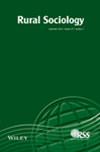“They Don't Want to Know; They Don't Want to Hear”: Social Distance Between Leaders and Low‐Income Community Members in a Rural Indiana Community☆
IF 1.9
3区 社会学
Q2 SOCIOLOGY
引用次数: 0
Abstract
Drawing on 65 in‐depth, semi‐structured interviews with community members and local leaders, this research examines and categorizes social distance between local leaders and low‐income community members in “Green Glen,” a rural Indiana community. We operationalize this distance as high, medium, and low based on leaders' connection to low‐income residents, knowledge of their livelihood strategies, and belief in culture of poverty rhetoric. High social distance leaders tend not to know any low‐income residents personally, know little about how they make ends meet, and rely upon culture of poverty explanations in discussions about them. Medium social distance leaders may have occasional interactions with low‐income residents or may have close personal ties with someone who does, tend to have some knowledge of how low‐income residents make ends meet, and use a combination of cultural and structural explanations when discussing poverty in Green Glen. Low social distance leaders have frequent interactions with low‐income residents, know a great deal about how they make ends meet, and point to local and national economic conditions that negatively impact the low‐income residents of the community. The amount of social distance may directly and indirectly impact low‐income community members' available resources and ability to make ends meet.“他们不想知道;“他们不想听”:印第安纳州农村社区领导人与低收入社区成员之间的社会距离
通过对社区成员和当地领导人的65次深入的半结构化访谈,本研究对印第安纳州农村社区“绿谷”的当地领导人和低收入社区成员之间的社会距离进行了调查和分类。我们根据领导者与低收入居民的联系、对其生计策略的了解以及对贫困修辞文化的信仰,将这种距离分为高、中、低。高社会距离领导者往往不认识任何低收入居民,对他们如何维持生计知之甚少,并在讨论他们时依赖贫困文化的解释。中等社会距离的领导者可能偶尔会与低收入居民互动,或者可能与低收入居民有密切的个人关系,他们往往对低收入居民如何维持生计有所了解,并在讨论格林格伦的贫困问题时使用文化和结构解释的结合。低社会距离领导者经常与低收入居民互动,非常了解他们如何维持生计,并指出当地和国家的经济状况对社区低收入居民产生负面影响。社会距离的大小可能直接或间接地影响低收入社区成员的可用资源和维持生计的能力。
本文章由计算机程序翻译,如有差异,请以英文原文为准。
求助全文
约1分钟内获得全文
求助全文
来源期刊

RURAL SOCIOLOGY
SOCIOLOGY-
CiteScore
4.60
自引率
13.00%
发文量
47
期刊介绍:
A forum for cutting-edge research, Rural Sociology explores sociological and interdisciplinary approaches to emerging social issues and new approaches to recurring social issues affecting rural people and places. The journal is particularly interested in advancing sociological theory and welcomes the use of a wide range of social science methodologies. Manuscripts that use a sociological perspective to address the effects of local and global systems on rural people and places, rural community revitalization, rural demographic changes, rural poverty, natural resource allocations, the environment, food and agricultural systems, and related topics from all regions of the world are welcome. Rural Sociology also accepts papers that significantly advance the measurement of key sociological concepts or provide well-documented critical analysis of one or more theories as these measures and analyses are related to rural sociology.
 求助内容:
求助内容: 应助结果提醒方式:
应助结果提醒方式:


